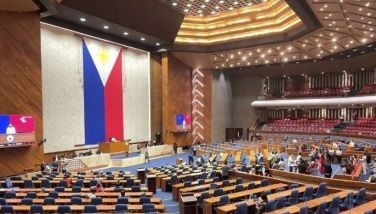Economic growth keeps upward trajectory
MANILA, Philippines – The country’s economic growth remains on an upward trajectory despite the anticipated slowdown in this year’s gross domestic product (GDP) expansion.
The National Economic and Development Authority (NEDA) has penciled growth at six percent this year, as the first three quarters averaged just 5.6 percent due mainly to government underspending, dismal agriculture performance, and the substantial impact of a number of natural disasters.
Economic Planning Secretary and NEDA director general Arsenio M. Balisacan points to the 6.2-percent average growth rate in GDP for the past five years as a basis for optimism.
“The growth trajectory is still on a strong positive upward curve,” Balisacan pointed out.
The government has likewise trimmed its economic growth forecast for 2016 at seven percent, down from the original range of seven to eight percent.
From an average two percent growth rate in the 1980 to 1989 period, economic expansion slightly improved to an average rate of 2.8 percent over the next 10-year period ending 1999.
It almost doubled to 4.5 percent in 2000-2009, proving its resiliency against external shocks due to strong fundamentals.
There are some concerns, however, when looking at the year-on-year performance, or from the 3.7 percent growth rate in 2011 to 6.7 percent the following year. Growth peaked at 7.1 percent in 2013 and corrected to 6.1 percent last year.
Nonetheless, the Philippines had remained among the best performers in the region, more often than not seconding only to Asian powerhouse China.
Concerns, however, have been raised over the strengthening of the economies of India and Vietnam. In the third quarter, the Philippines was only the fourth best performer behind India, China and Vietnam.
Strong domestic consumption remained among the pillars of strength buoyed by steady remittance inflows from overseas Filipinos and a robust business process outsourcing (BPO) sector.
“The industry and manufacturing sectors continue to strengthen, and the Philippines’ competitiveness ranking continues to rise from 85th in 2010 to 47th this year,” Balisacan said.
The country’s demographic profile likewise favors further growth as 66.63 million of an estimated population of over a 100 million are aged 15 years and over.
The employment level continues to grow from 38.84 million in 2014 to 39.78 million this year. Underemployment on the other hand, was reduced from 7.28 million last year to 7.05 million this year.
Unemployment likewise improved to 2.37 million this year from 2.48 million last year.
But to sustain the economy’s upward trajectory, government must continue infrastructure investments, innovation and broad reforms in the near term. “We must also support tourism by improving physical connectivity and peace,” Balisacan pointed out.
Assuming the short term goals are implemented and achieved, then quality jobs in labor-intense and high-quality production from agriculture, manufacturing and industry can be achieved.
“Human capital investment is critical, while the country must mitigate weather impacts on employment and society in general” the NEDA chief said.
Balisacan revealed that NEDA has initiated a nationwide survey supported by teams of experts that will put together Filipino 2040, a medium-term development plan or long-term vision.
It will be evidence-based or a product of nationwide consultations as well as existing data and targets, such as the Philippine Development Plan, the Millenium Development Plan (MDG), and the Sustainable Development Goals (SDG).
The intention is to craft a medium-term plan based on the aspirations and dreams of the Filipino for a better life and contextualize the dreams, he said.
A nationwide survey and consultation has already started, while another group is doing technical work on various topics, themes that are amendable to policy change, like health, education, environment, innovations, and other social issues.
It is set for a 25-year period since it will take several years and administrations to achieve what Balisacan calls “a modern nation.”
“No single administration can transform a poor nation into a rich nation. If we can sustain economic progress that we have achieved in the last three-to five years of over six percent average annual growth rate, we should be able to bring the country to the threshold of a modern or high-income country by 2040,” the economic planning chief said.
A modern or high-income level means a per capital income range of $8,000 to $12,000 from the country’s present level of $3,000.
- Latest
- Trending




























